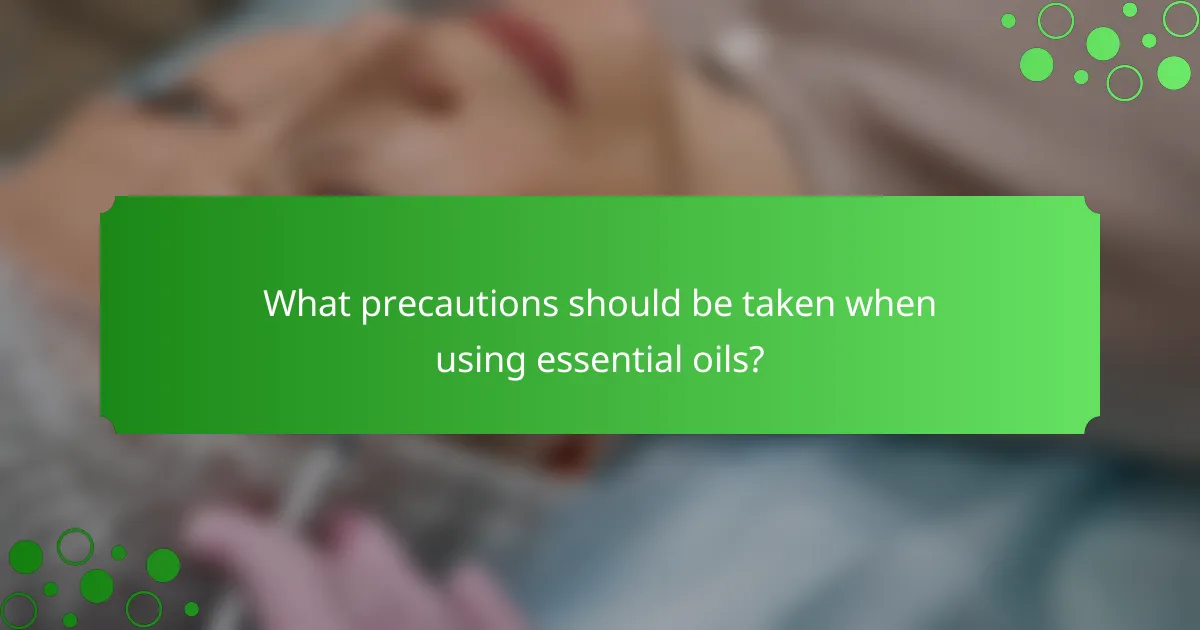Essential oils provide effective relief for stress and pain through their calming and analgesic properties. This article explores the benefits of oils like lavender and peppermint, their application methods such as diffusion and topical use, and essential safety precautions. Regular integration of these oils can enhance overall well-being and support long-term stress management.

How do essential oils alleviate stress and promote relaxation?
Essential oils effectively alleviate stress and promote relaxation through their calming properties and aromatic benefits. Oils like lavender and chamomile reduce anxiety and improve mood. Inhalation or topical application encourages relaxation, providing immediate relief. The unique attributes of specific oils enhance their effectiveness; for instance, lavender oil has a unique calming scent that significantly lowers cortisol levels. Regular use can lead to long-term stress management benefits.
Which essential oils are most effective for stress relief?
Lavender, chamomile, and bergamot are the most effective essential oils for stress relief. Lavender oil is renowned for its calming effects, often leading to improved sleep quality. Chamomile oil promotes relaxation and reduces anxiety, while bergamot oil can elevate mood and alleviate stress. These oils can be used through diffusion, topical application, or inhalation, providing versatile options for stress management.
What scientific evidence supports the use of essential oils for stress management?
Scientific evidence supports essential oils for stress management through various studies demonstrating their effectiveness. Research indicates that inhaling lavender oil can significantly reduce anxiety levels, improving overall mood. A study published in the Journal of Alternative and Complementary Medicine found that participants exposed to bergamot essential oil experienced lower cortisol levels, indicating reduced stress. Additionally, a meta-analysis highlighted the calming effects of chamomile oil, showing its potential in alleviating stress-related symptoms. These findings underscore the value of essential oils as a natural approach to stress relief.
How do individual responses to essential oils vary across demographics?
Individual responses to essential oils vary significantly across demographics due to factors like age, gender, and cultural background. For instance, younger individuals may prefer citrus oils for stress relief, while older adults might favour lavender for relaxation. Gender differences also play a role; studies indicate women often report stronger emotional responses to essential oils compared to men. Cultural influences shape preferences and beliefs regarding essential oils, affecting their perceived effectiveness. Additionally, individual health conditions and sensitivities can lead to unique reactions to specific oils. Understanding these variations can enhance the application methods for stress relief and pain management.

How can essential oils assist in pain management?
Essential oils can significantly assist in pain management through their analgesic and anti-inflammatory properties. Oils like lavender and peppermint are particularly effective in reducing muscle tension and alleviating headaches.
The application methods include topical use, diffusion, and inhalation. For instance, diluting essential oils in a carrier oil and massaging them onto sore areas can provide immediate relief.
Research indicates that aromatherapy with essential oils can lower pain perception, enhancing overall well-being. A study found that patients using essential oils reported a 30% reduction in pain intensity.
Incorporating essential oils into pain management routines can offer a natural, complementary approach alongside traditional treatments.
Which essential oils are commonly used for pain relief?
Common essential oils for pain relief include lavender, peppermint, eucalyptus, and ginger. These oils are known for their analgesic and anti-inflammatory properties. Lavender oil reduces muscle tension and promotes relaxation, while peppermint oil provides a cooling sensation that alleviates headaches. Eucalyptus oil can relieve joint pain, and ginger oil is effective for muscle soreness. Each oil can be applied through massage, diffusion, or topical use, enhancing overall pain management strategies.
What are the mechanisms by which essential oils reduce pain perception?
Essential oils reduce pain perception through various mechanisms, including modulation of neurotransmitters and anti-inflammatory effects. They interact with the body’s endocannabinoid system, enhancing pain relief by promoting relaxation and reducing stress. For example, lavender oil has been shown to lower cortisol levels, which can alleviate tension and discomfort. Additionally, certain oils like peppermint contain menthol, which provides a cooling sensation that distracts from pain.
How do essential oils compare to traditional pain management methods?
Essential oils offer a natural alternative to traditional pain management methods, often providing similar relief with fewer side effects. Essential oils like lavender and peppermint can reduce pain and stress through aromatherapy or topical application. Traditional methods, such as pharmaceuticals, may have more significant side effects and dependency risks. Essential oils are generally non-invasive, promoting relaxation and pain relief without the complications associated with medications.

What are the different methods of applying essential oils?
Essential oils can be applied through various methods, including inhalation, topical application, and diffusion. Inhalation involves breathing in the aroma directly or using a steam inhalation method. Topical application requires dilution with a carrier oil before applying to the skin, which enhances absorption and minimizes irritation. Diffusion utilizes a diffuser to disperse essential oils into the air, creating a calming atmosphere. Each method offers unique benefits for stress relief and pain management, catering to individual preferences and needs.
How does aromatherapy differ from topical application?
Aromatherapy utilizes essential oils for inhalation to promote mental and emotional well-being, while topical application involves directly applying oils to the skin for localized effects. Aromatherapy targets stress relief and relaxation through scent, whereas topical application focuses on pain management and skin conditions. Each method offers unique benefits, with aromatherapy enhancing mood and topical application providing physical relief. Understanding these differences can guide effective use of essential oils.
What are the benefits of using a diffuser versus direct inhalation?
Using a diffuser offers more consistent and prolonged exposure to essential oils compared to direct inhalation. Diffusers disperse essential oils into the air, allowing for a broader area of effect, while direct inhalation targets a smaller space and may lead to rapid evaporation.
Diffusing essential oils can enhance mood and relaxation over time, making it ideal for stress relief. In contrast, direct inhalation delivers immediate effects, which can be beneficial for acute situations like sudden anxiety or pain.
Additionally, diffusers can combine multiple oils, creating synergistic effects that enhance benefits. Direct inhalation limits this combination potential. Overall, using a diffuser promotes a more holistic and sustained experience with essential oils.
How can essential oils be safely blended for personal use?
To safely blend essential oils for personal use, follow a few key guidelines. Start by choosing oils with complementary properties for stress relief or pain management. Always dilute essential oils with a carrier oil, such as coconut or jojoba, to prevent skin irritation. A standard dilution ratio is 2-3 drops of essential oil per teaspoon of carrier oil. Conduct a patch test before full application to check for allergic reactions. Store blends in dark glass bottles to preserve their potency.

What precautions should be taken when using essential oils?
When using essential oils, it is crucial to take specific precautions to ensure safety and effectiveness. Always dilute essential oils with a carrier oil before topical application to prevent skin irritation. Conduct a patch test to check for allergic reactions. Avoid ingestion unless under professional guidance. Keep essential oils away from sensitive areas, such as eyes and mucous membranes. Pregnant or nursing individuals should consult a healthcare provider before use. Store essential oils in a cool, dark place to maintain their potency and safety.
Which individuals should avoid certain essential oils?
Individuals with certain health conditions should avoid specific essential oils. Pregnant women, individuals with asthma, and those with allergies may experience adverse reactions. People with skin sensitivities should also be cautious. Always consult a healthcare professional before use.
What are the potential side effects of essential oils?
Essential oils can cause side effects such as skin irritation, allergic reactions, and nausea. These effects vary based on the type of essential oil and method of application. For example, lavender oil may cause skin sensitivity in some individuals. Always dilute oils before topical use and consult a healthcare professional if unsure.

How can essential oils be integrated into daily routines for maximum benefit?
Essential oils can be integrated into daily routines by using them in diffusers, applying topically, or adding to baths. These methods enhance stress relief and pain management.
1. Diffusion: Use a diffuser in your workspace or home to create a calming atmosphere. Oils like lavender and chamomile promote relaxation.
2. Topical application: Dilute oils with a carrier oil and apply to pulse points for direct relief. Peppermint oil can alleviate headaches.
3. Bathing: Add a few drops of essential oils to bathwater for soothing effects. Eucalyptus oil can help with muscle tension.
4. Inhalation: Inhale directly from the bottle or a cotton ball for immediate stress relief. Citrus oils uplift mood effectively.
Integrating essential oils into your routine can enhance well-being through consistent application methods.
What are some creative ways to use essential oils at home or work?
Essential oils can be creatively used at home or work for stress relief and pain management through various methods. Diffusing oils like lavender or eucalyptus creates a calming atmosphere. Applying diluted oils topically on pulse points alleviates tension. Incorporating oils into massage blends enhances pain relief. Creating homemade cleaning products with essential oils combines cleanliness with aromatherapy benefits. Lastly, adding oils to baths promotes relaxation and mental clarity.
What expert tips can enhance the effectiveness of essential oils for stress and pain relief?
To enhance the effectiveness of essential oils for stress and pain relief, consider these expert tips. Use high-quality oils, as their purity influences efficacy. Dilute essential oils with a carrier oil for safe application. Apply oils through inhalation, topical massage, or in a diffuser for optimal results. Experiment with combinations, as certain blends, like lavender and chamomile, may enhance relaxation and pain relief. Consistency in use can improve outcomes, so incorporate oils into your daily routine.